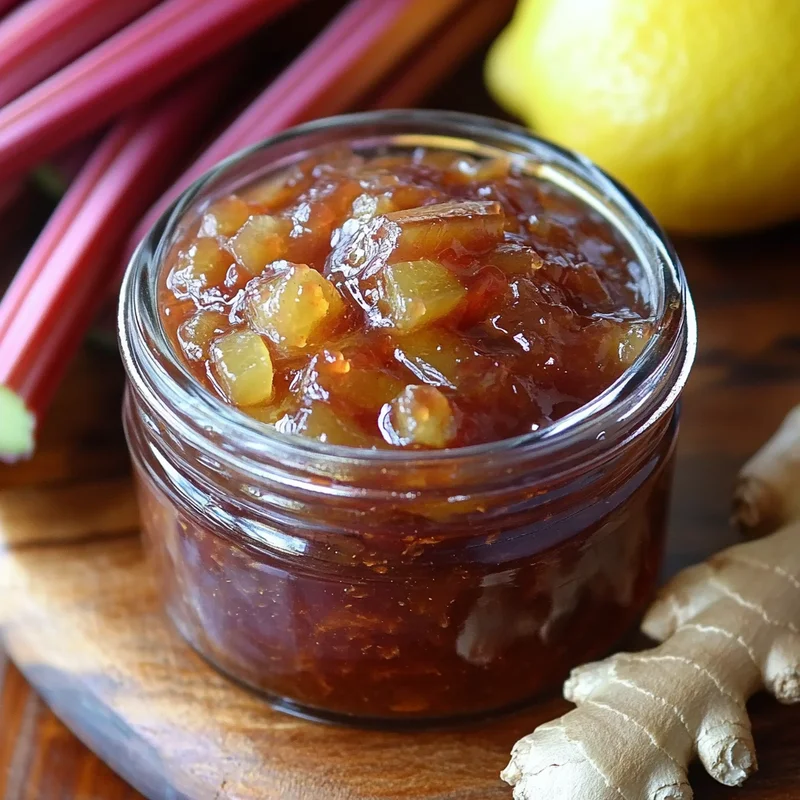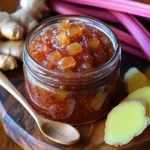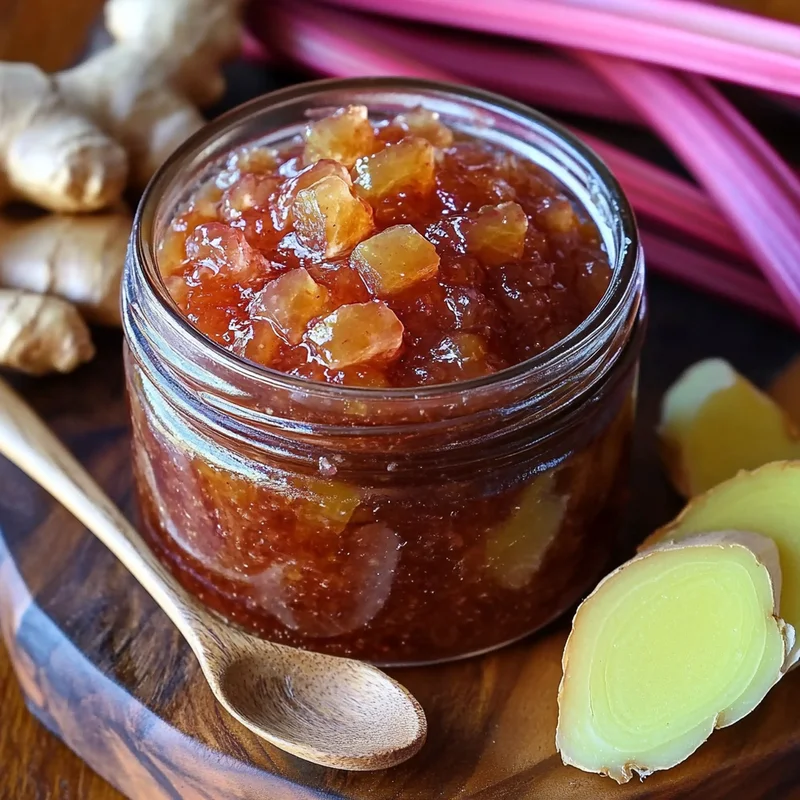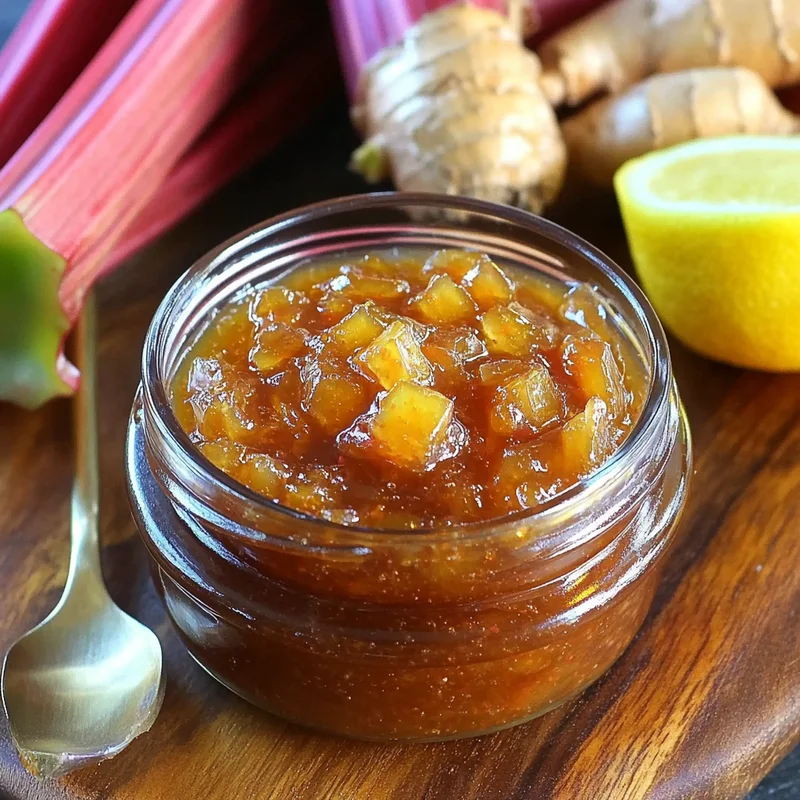Introduction
Oh, friend, let me tell you about one of my absolute favorite kitchen moments: turning a bounty of fresh, seasonal produce into something truly magical. And nothing feels quite as magical as a batch of homemade jam! There’s just something about those jewel-toned jars lined up on the counter. This Rhubarb Ginger Jam? It’s a showstopper. If you’ve ever thought making jam was complicated or scary, you are in for such a sweet surprise. This recipe is so straightforward, so rewarding, and tastes like pure sunshine in a jar. It’s the perfect way to capture the fleeting beauty of rhubarb season and add a little zing to your life!
Why You’ll Love This Recipe
- Fast: Seriously, from start to finished jars, it’s quicker than you think!
- Easy: No fancy techniques needed, just simple stirring and watching the magic happen.
- Giftable: Who doesn’t love a beautiful jar of homemade jam? It’s the perfect hostess gift or thoughtful present.
- Crowd-pleasing: The sweet and tangy rhubarb paired with the warm kick of ginger is a combination everyone adores.
Ingredients
Gather ’round, here’s what you’ll need for this little pot of gold:
- 400 g chopped rhubarb: Aim for lovely, narrow stalks. Give them a quick trim and chop them up. This is the heart of our jam!
- 30 g crystallised stem ginger, finely chopped: This is where that wonderful warm spice comes from. Crystallised ginger adds sweetness and a lovely chewy texture.
- 400 g granulated sugar: Sugar isn’t just for sweetness here; it helps the jam set beautifully and preserves it.
- 2 tbsp lemon juice, freshly squeezed: A little squeeze of lemon juice brightens everything up and also helps with the setting process.
How to Make It
Alright, let’s get cooking! Don’t be intimidated; we’ll take it one simple step at a time.
First things first, grab your biggest, heaviest-based pan. You want one that gives the jam plenty of room to bubble. Toss in your chopped rhubarb, the granulated sugar, and the fresh lemon juice.
Place the pan over a gentle heat. Your mission right now is to just get that sugar to dissolve. Give it a little stir every now and then. You’ll see the rhubarb start to soften and release its lovely pink juices as the sugar melts away. Be patient here; you don’t want any sugar grains left before you turn up the heat.
Once you’re sure all the sugar crystals have disappeared, it’s time to get things moving! Turn up the heat and bring the mixture to a proper, rolling boil. You’ll see lots of active bubbles all over the surface.
Now, carefully stir in that finely chopped crystallised ginger. Oh, doesn’t it smell amazing already?
Keep boiling the jam rapidly, stirring frequently. This is the stage where the magic really happens – the jam thickens! You’ll need to keep an eye on it and stir often to prevent it from sticking to the bottom. How do you know it’s ready? This is called reaching the ‘setting point’. It typically happens around 105°C (that’s about 220°F), but don’t worry if you don’t have a thermometer. The best way is to put a small amount on a plate you’ve chilled in the freezer for a few minutes. Let it cool for 30 seconds, then push it gently with your finger. If it wrinkles and sets up quickly, it’s ready! If it just runs everywhere, keep boiling and test again in a few minutes. I usually start testing after about 10-15 minutes of rapid boiling, depending on the pan and heat.
Once it’s reached that perfect setting point, take the pan off the heat immediately.
You might see a little bit of foam on the surface. Just gently skim it off with a spoon; it makes the jam look much clearer and prettier in the jar.
Now for the final step! Carefully ladle the hot jam into your sterilised jars. Fill them up close to the top, but leave a little gap (just below the rim is perfect).
Pop the sterilised lids straight onto the hot jars and seal them tightly. As the jam cools, it will create a vacuum seal, which keeps it fresh for ages!
Substitutions & Additions
Want to play around a little? Here are some ideas:
- Fresh Ginger: Not a fan of crystallised? Use about 1-2 tablespoons of freshly grated ginger instead. Add it in with the rhubarb at the start for a punchier, less sweet ginger flavor.
- Vanilla Bean: Scrape in half a vanilla bean or add a teaspoon of vanilla extract (add extract after taking off the heat) for a lovely warm undertone.
- Spice It Up: A pinch of ground cardamom or a star anise added while boiling can add another layer of warmth. Remove the star anise before jarring.
- Mixed Fruit: Rhubarb pairs beautifully with other fruits! Try adding a cup of chopped strawberries, raspberries, or even apples to the mix. Adjust sugar slightly if using very sweet fruits.

Tips for Success
- Choose Your Rhubarb: Younger, thinner stalks are less stringy and more tender. The color doesn’t always indicate sweetness, but those lovely pink stalks sure make for pretty jam!
- Sterilize Your Jars! This is crucial for safe, shelf-stable jam. You can run them through a hot dishwasher cycle, heat them in the oven (empty jars at 275°F for 20 mins), or boil them and their lids. Make sure they are hot when you fill them.
- Don’t Skip Stirring: Especially during the rapid boil, frequent stirring prevents the jam from burning on the bottom of the pan.
- Know the Setting Point: The cold plate test is your best friend! Don’t rush this step. Jam that hasn’t boiled long enough will be runny. Jam that boils too long can be too stiff or even burn.
- Use a Big Pan: Jam bubbles up quite a bit when boiling rapidly. Using a large, deep pan prevents sticky boil-overs.
How to Store It
Once your jars are sealed and cooled, you can store them in a cool, dark place (like a pantry) for up to a year. Isn’t that amazing?
After opening a jar, keep it in the refrigerator. It should stay good for several weeks, though honestly, a jar of this jam rarely lasts that long in my house!
FAQs
Got questions? I’ve got (brief!) answers!
Q: Can I use frozen rhubarb?
A: Yes, absolutely! Thaw it first and drain off any excess liquid before weighing and adding it to the pan.
Q: How do I know if my jars are sealed?
A: As they cool, the lid should “pop” inwards. Once completely cool (give it 12-24 hours), the center of the lid should be concave and shouldn’t flex up and down when you press it.
Q: What is “setting point”?
A: It’s the temperature (or consistency) where the sugar concentration is just right for the jam to thicken and set as it cools. The cold plate test is the easiest way to check at home without special equipment.
Sweet & Tangy Homemade Rhubarb Ginger Jam

Turn seasonal rhubarb into a magical batch of homemade jam! This recipe is straightforward, rewarding, and captures the fleeting beauty of rhubarb season with a sweet and tangy flavor profile and a warm kick of ginger. It’s surprisingly fast and easy, making it perfect for gifting or enjoying yourself.
- Heavy-based pan
- Spoon
- Jar(s)
- lids
- Plate
Main Ingredients
- 400 g chopped rhubarb (Aim for lovely, narrow stalks. Give them a quick trim and chop them up.)
- 30 g crystallised stem ginger (finely chopped)
- 400 g granulated sugar
- 2 tbsp lemon juice (freshly squeezed)
- Grab your biggest, heaviest-based pan. Toss in your chopped rhubarb, the granulated sugar, and the fresh lemon juice.
- Place the pan over a gentle heat to dissolve the sugar. Stir every now and then until all sugar crystals have disappeared.
- Once sugar is dissolved, turn up the heat and bring the mixture to a proper, rolling boil.
- Carefully stir in the finely chopped crystallised ginger.
- Keep boiling the jam rapidly, stirring frequently, until it reaches the setting point. Test by putting a small amount on a chilled plate, letting it cool, and pushing it with your finger (it should wrinkle and set quickly). This typically takes about 10-15 minutes of rapid boiling.
- Once the setting point is reached, take the pan off the heat immediately.
- Gently skim off any foam on the surface with a spoon.
- Carefully ladle the hot jam into sterilised jars, filling them close to the top but leaving a little gap.
- Pop the sterilised lids straight onto the hot jars and seal them tightly.
Tips for Success:
– Choose younger, thinner rhubarb stalks for less stringiness.
– Sterilize your jars and lids thoroughly. Jars can be sterilised in a hot dishwasher cycle, oven (275°F for 20 mins), or by boiling. Ensure they are hot when filled.
– Don’t skip stirring, especially during the rapid boil, to prevent burning.
– The cold plate test is the best way to check for the setting point if you don’t have a thermometer. Jam that hasn’t boiled enough will be runny; too long can make it too stiff.
– Using a large, deep pan prevents sticky boil-overs.
Storage:
– Once jars are sealed and cooled, store them in a cool, dark place for up to a year.
– After opening, keep jars in the refrigerator for several weeks.
FAQs:
– Frozen rhubarb can be used; thaw first and drain excess liquid.
– Jars are sealed if the lid pops inwards as it cools and the center is concave/doesn’t flex when pressed after cooling (12-24 hours).
– Setting point is the temperature/consistency where the jam thickens as it cools.


